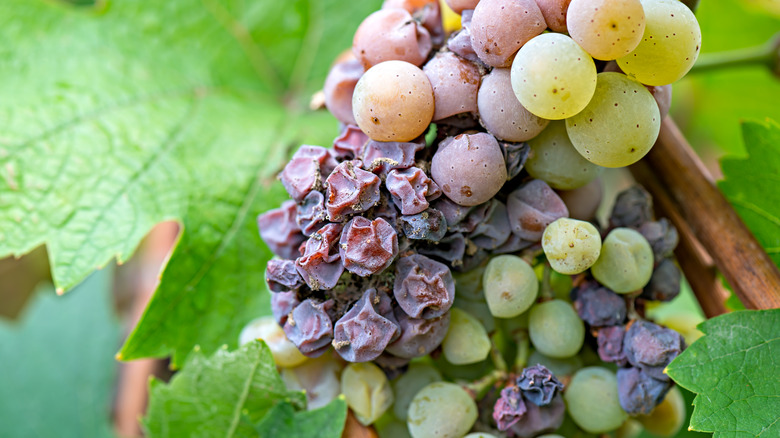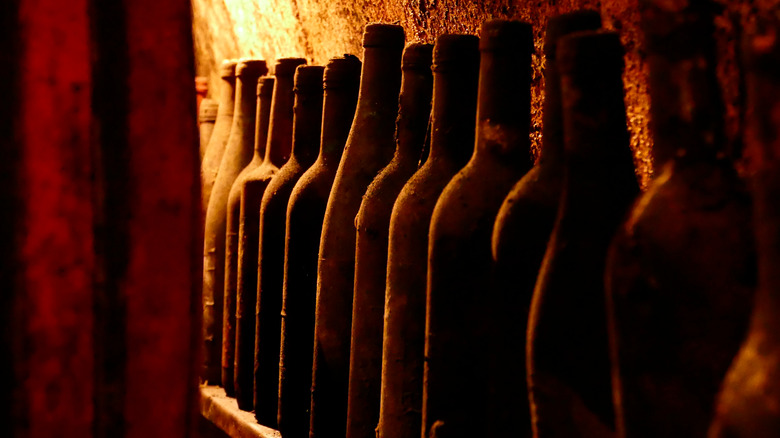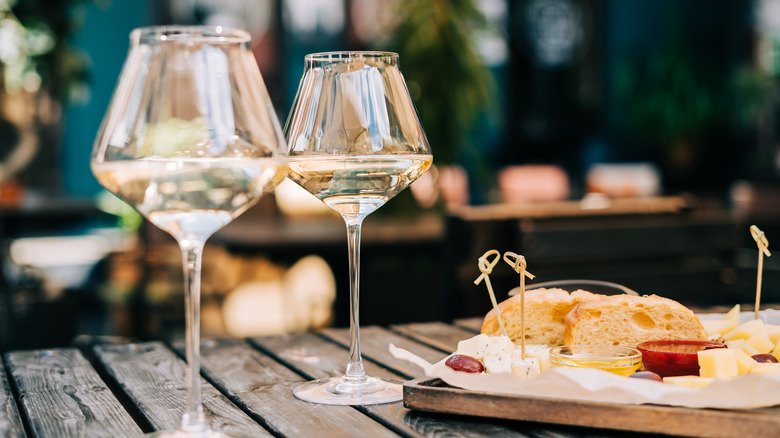Why The Noble Rot Fungus Is Actually A Good Thing For Wine
While rotting fruit is usually a sign to throw out produce for home cooks and agricultural growers alike, there's a certain type of fungi that is actually quite sought-after by winemakers in certain regions of the world. Botrytis cinerea, a type of fungi lovingly known in the wine community as noble rot, has a special effect on grapes to make an extra sweet, intensely flavorful wine, assuming the growing conditions are right.
In recent years, more has been uncovered about the functional benefit of fungi, like mushrooms, and as used in a variety of fermented foods (think: cheese, beer, and soy sauce). But what sets apart the sweet wines made from noble rot is the fact that wine is very specific to the regional and climate conditions in which the grapes are cultivated.
When specific varieties of thin-skinned grapes, grown mostly in vineyards proximal to water, experience the infamous noble rot, something quite magical happens. This particular fungi works to suck the moisture from the fruit, making the grapes' flavor, acidity, and even spiced notes more concentrated, resulting in extra sweet, complexly floral wine with what often is described as having honey, caramelized, and even pineapple undertones.
What makes noble rot wines unique
When it comes to grapes affected by noble rot fungi, it truly takes a set of precise conditions and wise care from cultivating the grapes to harvesting them by hand. Noble rot occurs in specific areas where the moisture and humidity in the air is plentiful on fall mornings when the grapes are ripe. This is why areas known for growing noble rot varieties of sweet wine are almost exclusively located near bodies of water, including lakes and rivers.
Foggy, misty conditions in the morning introduce moisture to the grapes and eventually a fungal fuzz forms on the exterior of the ripe fruit, absorbing moisture through the grape's thin skin. Key to this fungal rot's beneficial ways are the sunny days that follow those damp mornings, in order to dry out the fruit (since too much moisture or rainfall can take out an entire crop of the rotting grapes).
This process occurs each day during the fall growing season prior to harvest, and the fungi continually absorbs the grapes' moisture, resulting in tiny dried wine-making grapes that look similar to raisins, that have highly concentrated levels of sugar and tart acidity. When used to make wine by either fermenting and aging the yields, or mashing the rotted fruit into a paste and adding to other types of wine to undergo a second fermentation which adds flavor intensity, the flavor is deeply complex, sugary, with an undeniably tart, crisp finish.
How to enjoy noble rot wine
The grapes made to produce noble rot wine are grown in specific areas, such as several varieties from the Bordeaux region of France including Sauternes, sweet rieslings from Germany, and Tokaji from Hungary. The rotted fruit also serves to pair well in the process of making certain kinds of ice wines, which are also extra sugary and made from grapes that are allowed to hang out on the vines during the frosting cold temps of winter.
Wherever they are grown, these climate-specific varieties of noble rot grapes dry out and shrivel on the vine quite inconsistently and need to be hand-picked by growers across several weeks (or months). This, combined with the fact that the dried-out grapes contain far less moisture than typical grapes used for making wine, results in lower yields of liquid, which makes a bottle of the prized stuff pretty expensive.
Noble rot wines are golden in color and have signature sweetness and caramelized flavors, and are enjoyed perfectly with charcuterie or for dessert served alongside treats like chocolate soufflé cake. You can also pair the complexly sweet and fruitfully-deep wine with savory meals like grilled salmon with tomato-olive salsa to seriously elevate a summer dinner spent on the porch. Noble rot wine also makes for an excellent spritzer or cocktail when included in the making of inventive mixed drinks like vin de maison hibiscus wine. However you enjoy the fruits of Noble rot, be sure to savor every taste.


